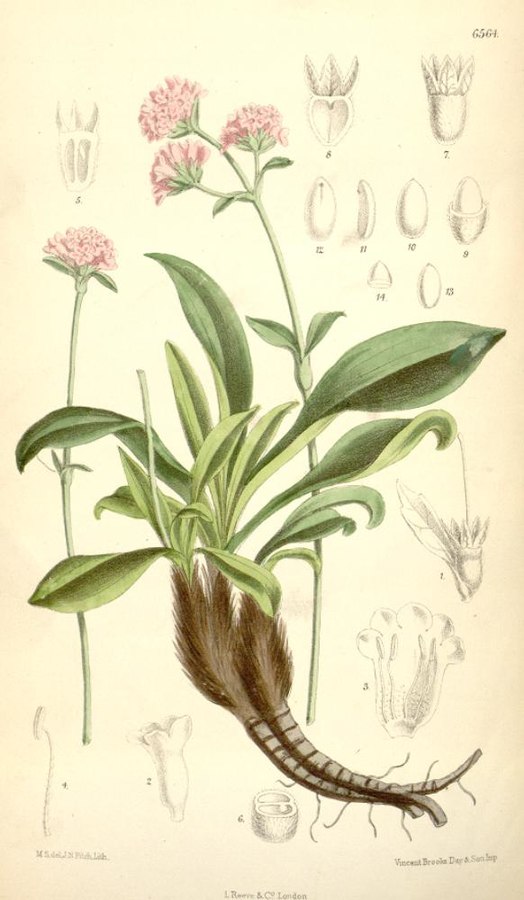 Spikenard (Nardostachys jatamansi) is a perennial flowering plant belonging to the same family as valerian (the Valerianaceae family). Other names for spikenard include nardin, muskroot and nard. Spikenard is found in parts of Asia where it grows to about 1 meter in height. The plant produced pink bell-shaped flowers and a rhizome that contains an essential oil that may have medicinal properties including antioxidant, and hepatoprotective effects. The medicinal properties of spikenard root also includes a number of effects on the central nervous system, including a sedative, anticonvulsant and anxiolytic effect. For example, the central nervous system effects of spikenard were investigated in rats. In this regard, administration of spikenard root extract to rats significantly increased the threshold upon which seizures could be experimentally caused in the rats. At the same time no neurotoxicity was observed in the rats administered spikenard root extract.
Spikenard (Nardostachys jatamansi) is a perennial flowering plant belonging to the same family as valerian (the Valerianaceae family). Other names for spikenard include nardin, muskroot and nard. Spikenard is found in parts of Asia where it grows to about 1 meter in height. The plant produced pink bell-shaped flowers and a rhizome that contains an essential oil that may have medicinal properties including antioxidant, and hepatoprotective effects. The medicinal properties of spikenard root also includes a number of effects on the central nervous system, including a sedative, anticonvulsant and anxiolytic effect. For example, the central nervous system effects of spikenard were investigated in rats. In this regard, administration of spikenard root extract to rats significantly increased the threshold upon which seizures could be experimentally caused in the rats. At the same time no neurotoxicity was observed in the rats administered spikenard root extract.
In another study, the central nervous system effects of spikenard were assessed in mice. Three doses of spikenard root extracts were administered to mice and the effects on learning and memory assessed. The highest dose of spikenard significantly improved the memory of the mice and revered amnesia that was artificially induced by administration of the benzodiazepine drug diazepam and the alkaloid scopolamine. In addition, the spikenard extract also reversed the decline in memory attributed to the natural ageing of the mice. The authors concluded that the central nervous system effects on memory might be attributable to the antioxidant effects of the herb. The antioxidant effects of spikenard were also suggested to be responsible for the anti-stress effects observed in another study involving rats. When rats were administered spikenard, there were effects consistent with an antioxidant effect, and a number of markers of stress concomitantly were reduced.

The roots of spikenard contain a number of chemicals that may explain the medicinal properties seen in the herb. These include an essential oil that comprises of about 0.5 % of the root. Within the root are also a number of chemicals including a number of sesquiterpenes and coumarins. Jatamansone is the principle sesquiterpene, with other sesquiterpenes including nardostachone, dihydrojatamansin, jatamansinol, jatamansic acid. jatamansinone, jatamansinol, oroseolol, oroselone, seselin, valeranal, nardostachyin. nardosinone, spirojatamol, jatamol A and B, calarenol, seychellene and seychelane. Courmarins present in the roots of spikenard include jatamansin or xanthogalin. Other components within the roots include resins, sugars, starch, gums, lignins, bitter extractive matter and β-sitosterol. Image from: By Joseph Dalton Hooker (1817-1911) – Curtis’s botanical magazine vol. 107 ser. 3 nr. 37 tabl. 6564 from www.botanicus.org, Public Domain, https:// commons.wikimedia.org/w/ index.php? curid=2120319.
An antidepressant effect for root extracts of spikenard has also been demonstrated. Mice administered spikenard extracts displayed significant changes to their behaviour which was indicative of an antidepressant effect. At the same time, the researcher observed that inhibition to the enzymes monoamine oxidase A and monoamine oxidase B had occured. Further it was shown that component of the spikenard root extract may interact with the GABAB receptor in the brains of the mice. In another study using rats, researchers observed significant reductions in experimentally induced oxidative stress with administration of spikenard extracts. In addition, the spikenard extracts also significantly attenuated changes to levels of monoamines in the brains of the rats following stress exposure. Therefore spikenard may possess significant antistress and antioxidant effects that prevent changes to the neurochemistry of the brain, and this may protect from the development of mood disorders such as anxiety and depression.
Eat Well, Stay Healthy, Protect Yourself
RdB
